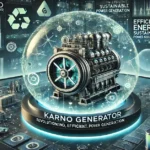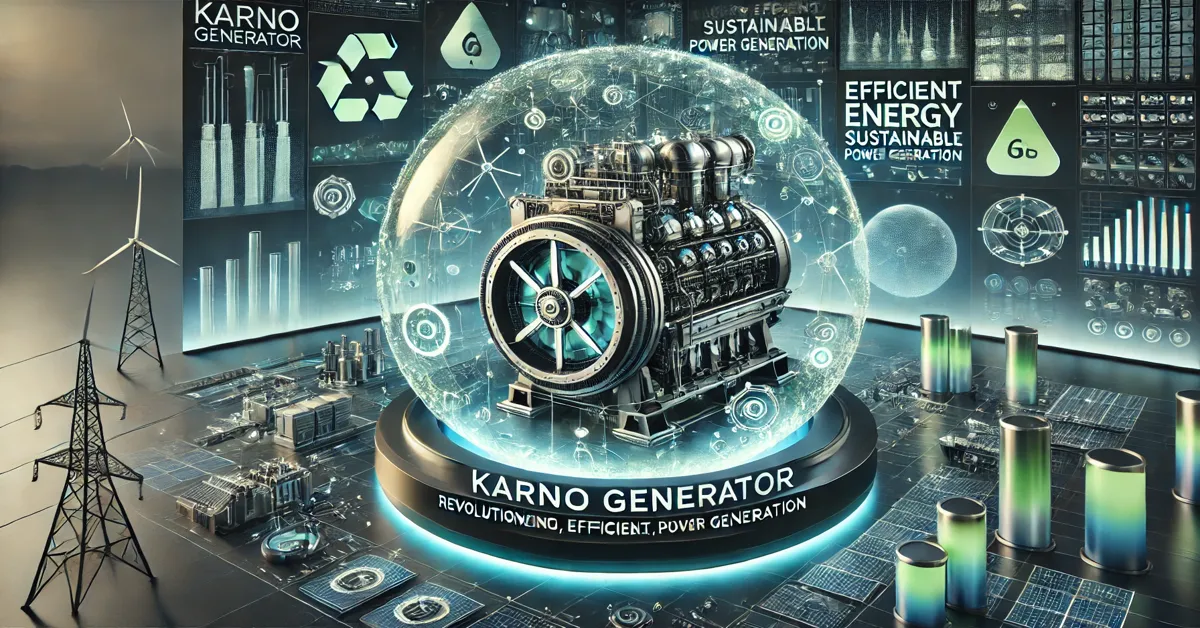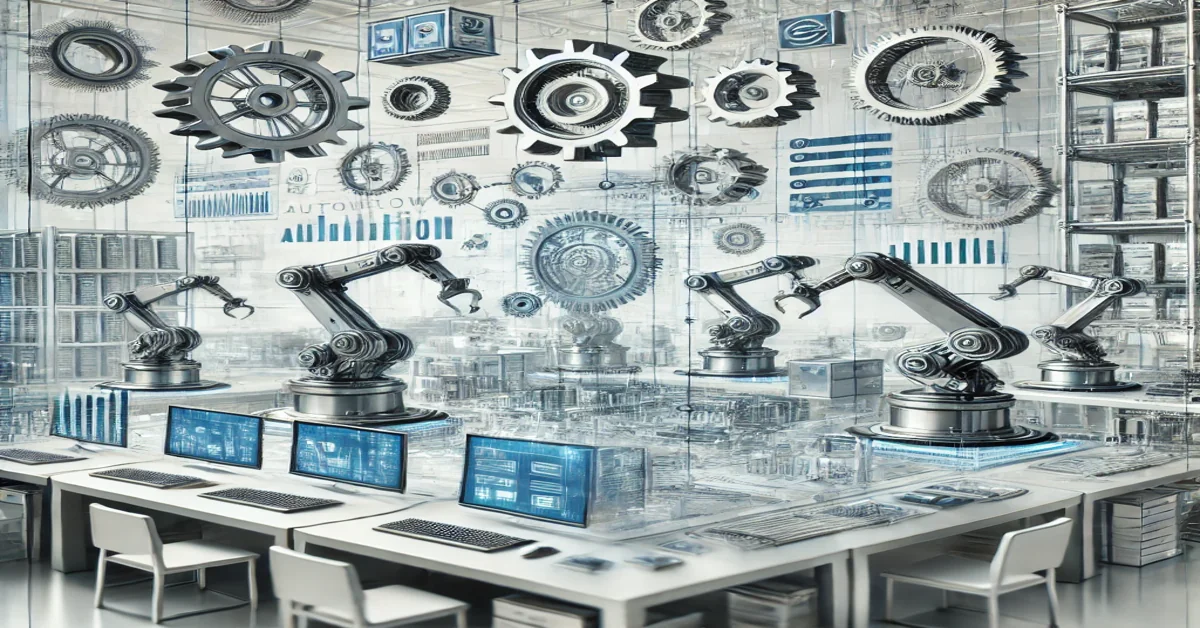As the world shifts toward cleaner and more efficient energy solutions, the demand for cutting-edge technologies in power generation is becoming more critical than ever. The Karno Generator, based on the principles of the Carnot cycle, is emerging as one of the most innovative and efficient power generation technologies. Recent updates to the Karno Generator have significantly improved its efficiency, adaptability, and environmental sustainability, making it a game-changing development in the energy sector.
This article delves into the Karno Generator’s technological advancements, its applications across various industries, and its implications for the global energy landscape. We will also explore the latest updates, how they enhance the generator’s performance, and what the future holds for this revolutionary technology. Finally, we will address six frequently asked questions (FAQs) to help clarify any additional aspects related to the Karno Generator.
What is the Karno Generator?
The Karno Generator is an advanced energy generation system that utilizes a modified version of the Carnot cycle, the most efficient thermodynamic cycle possible for converting heat into work. Named after the French physicist Sadi Carnot, the Carnot cycle is a theoretical construct used to define the maximum efficiency of any heat engine operating between two temperature extremes.
The Karno Generator takes this concept further by applying modern engineering, advanced materials, and innovative heat management techniques to create a highly efficient and adaptable energy generation system. It operates by transferring heat between hot and cold reservoirs and extracting energy from the process through mechanical work, which is then converted into electricity.
The versatility of the Karno Generator allows it to operate on various heat sources, including natural gas, hydrogen, biofuels, and renewable energy. Its ability to work across multiple industries, from transportation to industrial power generation, positions it as a key player in the transition to more sustainable energy solutions.
The Core Technology of the Karno Generator
The Carnot Cycle in Practice
At the core of the Karno Generator is its reliance on the Carnot cycle, which involves four key processes:
- Isothermal Expansion: Heat is absorbed from a high-temperature source while the working fluid (usually a gas) expands, doing work on the surroundings.
- Adiabatic Expansion: The working fluid continues to expand without any heat exchange, reducing its temperature as it does work.
- Isothermal Compression: The working fluid is compressed at a lower temperature, releasing heat to a cold reservoir.
- Adiabatic Compression: The fluid is compressed without heat exchange, raising its temperature back to the starting point.
The Karno Generator’s innovative design optimizes each of these steps to minimize energy loss, maximize efficiency, and ensure that as much heat as possible is converted into usable electricity.
Key Components of the Karno Generator
- Heat Exchanger: The heat exchanger is critical to the Karno Generator’s performance, as it transfers heat from the fuel source to the working fluid. By maximizing heat transfer efficiency, the generator extracts more energy from the fuel, improving overall performance.
- Working Fluid: The choice of working fluid in the Karno Generator is essential for its efficiency. The fluid must be able to withstand high pressures and temperatures while maintaining its thermodynamic properties. Advances in fluid dynamics and material science have allowed engineers to select fluids that are better suited for the generator’s operating conditions.
- Compression and Expansion Chambers: The generator uses specially designed chambers to compress and expand the working fluid, ensuring that the Carnot cycle is executed with minimal energy loss. These chambers are engineered to handle the high pressures and temperatures involved, optimizing the thermodynamic cycle.
- Exhaust Heat Recovery: To further improve efficiency, the Karno Generator is equipped with an exhaust heat recovery system. This system captures waste heat from the exhaust and reuses it within the cycle, reducing overall fuel consumption and increasing net power output.
Recent Updates and Advancements in Karno Generator Technology
The Karno Generator has undergone several significant updates in recent years, making it more efficient, versatile, and environmentally friendly. These advancements are set to revolutionize the way we generate and consume power, offering new possibilities for industries and consumers alike.
1. Enhanced Fuel Flexibility and Hydrogen Compatibility
One of the most notable updates to the Karno Generator is its increased fuel flexibility. Originally designed to operate primarily on natural gas, the generator can now run on a wider variety of fuels, including hydrogen, biofuels, and even waste heat from industrial processes.
The ability to run on hydrogen is particularly important, as hydrogen is being increasingly recognized as a key fuel in the transition to a low-carbon economy. Many countries are investing in hydrogen infrastructure, and industries are adopting hydrogen-based technologies as part of their decarbonization strategies. The Karno Generator’s hydrogen compatibility makes it well-suited for future energy markets.
2. Increased Efficiency Through Materials Innovation
The efficiency of the Karno Generator has been significantly boosted by the introduction of new, high-performance materials. These materials, including advanced ceramics and high-temperature alloys, allow the generator to operate at much higher temperatures than conventional generators, resulting in better energy conversion efficiency.
Operating at higher temperatures means that more of the heat energy from the fuel can be converted into electricity, reducing waste and improving overall performance. In addition to increasing efficiency, these materials also enhance the durability of the generator, reducing maintenance costs and extending its operational lifespan.
3. Modular Design for Scalability
The latest version of the Karno Generator features a modular design, allowing it to be scaled up or down depending on the energy needs of the user. This makes it suitable for a wide range of applications, from small residential energy systems to large industrial power plants.
The modular design also simplifies maintenance and upgrades, as individual modules can be replaced or enhanced without taking the entire system offline. This flexibility is particularly valuable in industries that require continuous power generation, as it minimizes downtime and ensures a steady supply of electricity.
4. Integration with Renewable Energy Sources
As renewable energy becomes more prevalent, the ability to integrate with these sources is crucial for any modern power generation technology. The Karno Generator has been updated to work seamlessly with renewable energy systems, such as solar and wind power.
For example, in solar power applications, the Karno Generator can capture excess heat produced by photovoltaic panels and convert it into electricity. In wind power systems, the generator can act as a backup, providing power when wind conditions are not optimal. This ability to complement renewable energy sources makes the Karno Generator a valuable tool for improving the reliability and efficiency of green energy systems.
5. Lower Emissions and Environmental Impact
One of the primary motivations behind the development of the Karno Generator is the need to reduce greenhouse gas emissions. The latest updates to the generator have further reduced its emissions profile, making it one of the cleanest energy generation technologies available.
By using hydrogen and biofuels as primary fuel sources, the Karno Generator produces minimal carbon emissions. Additionally, its high efficiency means that less fuel is required to generate the same amount of electricity, further reducing its environmental impact.
6. Digital Monitoring and Optimization
The incorporation of digital monitoring and optimization systems is another key update in the latest Karno Generator models. Using advanced sensors and Internet of Things (IoT) technology, the generator can continuously monitor its performance and make real-time adjustments to improve efficiency.
This allows for predictive maintenance, as the system can detect potential issues before they lead to failures or breakdowns. For industries that rely on continuous power generation, such as manufacturing or data centers, these digital capabilities are critical for ensuring reliable and cost-effective operation.
Applications of the Karno Generator
The versatility of the Karno Generator allows it to be used in a wide range of applications, from small-scale residential energy systems to large industrial power plants. Below are some of the key industries and sectors where the Karno Generator is making a significant impact.
1. Automotive Industry
The automotive industry is one of the primary beneficiaries of the Karno Generator’s technology. With the growing demand for electric vehicles (EVs), there is a need for efficient and reliable power generation systems that can extend the range of EVs and reduce their reliance on battery storage.
The Karno Generator can be integrated into hybrid vehicles or used as a range extender for EVs, providing a clean and efficient alternative to traditional internal combustion engines. Its ability to run on hydrogen and other alternative fuels also aligns with the automotive industry’s move towards more sustainable transportation solutions.
2. Industrial Power Generation
For industries that require large amounts of continuous power, such as manufacturing, petrochemicals, and mining, the Karno Generator offers a highly efficient and scalable solution. Its modular design allows it to be adapted to the specific energy needs of each industry, while its high efficiency reduces fuel consumption and operating costs.
Additionally, the Karno Generator’s ability to run on multiple fuel types, including hydrogen and biofuels, makes it a flexible option for industries looking to reduce their carbon footprints without compromising on power reliability.
3. Grid Stabilization and Backup Power
The Karno Generator’s quick startup time and high efficiency make it an ideal solution for grid stabilization and backup power applications. As renewable energy sources like wind and solar are intermittent, there is often a need for backup power generation to stabilize the grid during periods of low renewable output.
The Karno Generator can be deployed to provide reliable backup power in these situations, ensuring that the grid remains stable and that critical infrastructure, such as hospitals or data centers, continues to receive electricity.
4. Residential and Commercial Energy Systems
The Karno Generator’s modular design and fuel flexibility make it suitable for residential and commercial energy systems. Homeowners looking for a reliable and efficient way to generate electricity can use the Karno Generator in combination with solar panels or other renewable energy sources, reducing their reliance on the grid and lowering their energy costs.
Similarly, businesses can use the Karno Generator to power their operations, reducing their carbon footprints and improving energy efficiency. Its ability to integrate with existing energy systems makes it a versatile and cost-effective option for both small and large-scale users.
5. Marine and Aerospace Applications
The compact and efficient design of the Karno Generator makes it an attractive option for marine and aerospace applications. Ships and aircraft require reliable, lightweight power generation systems, and the Karno Generator’s ability to operate on a variety of fuels gives it a competitive edge in these industries.
For example, in the marine industry, the Karno Generator can be used to power cargo ships, reducing their reliance on traditional fossil fuels and lowering emissions. In aerospace, the generator can provide backup power for aircraft or be integrated into hybrid propulsion systems.
The Future of the Karno Generator
The future of the Karno Generator looks promising as ongoing advancements continue to enhance its performance and versatility. With countries and industries committing to reducing their carbon emissions and transitioning to more sustainable energy sources, the Karno Generator is well-positioned to play a key role in the global energy transition.
As hydrogen and biofuels become more widely adopted, the Karno Generator’s ability to run on these fuels will make it an increasingly valuable tool for industries and consumers alike. Additionally, its modular design and digital optimization capabilities ensure that it can adapt to the evolving energy landscape and meet the growing demand for clean, efficient power generation.
Conclusion
The Karno Generator is a groundbreaking technology that is revolutionizing the way we generate and consume electricity. With its high efficiency, fuel flexibility, and ability to integrate with renewable energy systems, the Karno Generator is well-positioned to play a key role in the global transition to cleaner and more sustainable energy sources.
As ongoing updates and innovations continue to improve the generator’s performance, we can expect to see the Karno Generator being adopted across a wide range of industries and applications, from automotive and industrial power generation to grid stabilization and residential energy systems. Its ability to operate on hydrogen and other alternative fuels further cements its place as a leader in the future of power generation.
FAQs
1. What is the Karno Generator?
The Karno Generator is an advanced energy generation system that operates on the principles of the Carnot cycle, the most efficient thermodynamic process for converting heat into work. It is designed to produce electricity from a variety of heat sources, including natural gas, hydrogen, and biofuels.
2. How does the Karno Generator work?
The Karno Generator uses a modified version of the Carnot cycle to convert heat into mechanical work, which is then converted into electricity. It operates by transferring heat between hot and cold reservoirs, with the working fluid undergoing a series of compression and expansion processes to extract energy.
3. What are the latest updates to the Karno Generator?
Recent updates to the Karno Generator include enhanced fuel flexibility, increased efficiency through materials innovation, modular design for scalability, integration with renewable energy systems, reduced emissions, and the addition of digital monitoring and optimization features.
4. What fuels can the Karno Generator run on?
The Karno Generator can run on a wide range of fuels, including natural gas, hydrogen, biofuels, and waste heat from industrial processes. Its ability to use hydrogen is particularly important, as hydrogen is expected to play a key role in the future of energy.
5. What industries can benefit from the Karno Generator?
The Karno Generator is suitable for a variety of industries, including automotive, industrial power generation, grid stabilization, marine and aerospace, and residential and commercial energy systems.
6. How does the Karno Generator contribute to sustainability?
The Karno Generator contributes to sustainability by operating on cleaner fuels, such as hydrogen and biofuels, and by minimizing fuel consumption through its high efficiency. Its ability to integrate with renewable energy sources also makes it a valuable tool for reducing greenhouse gas emissions and promoting a more sustainable energy future.











